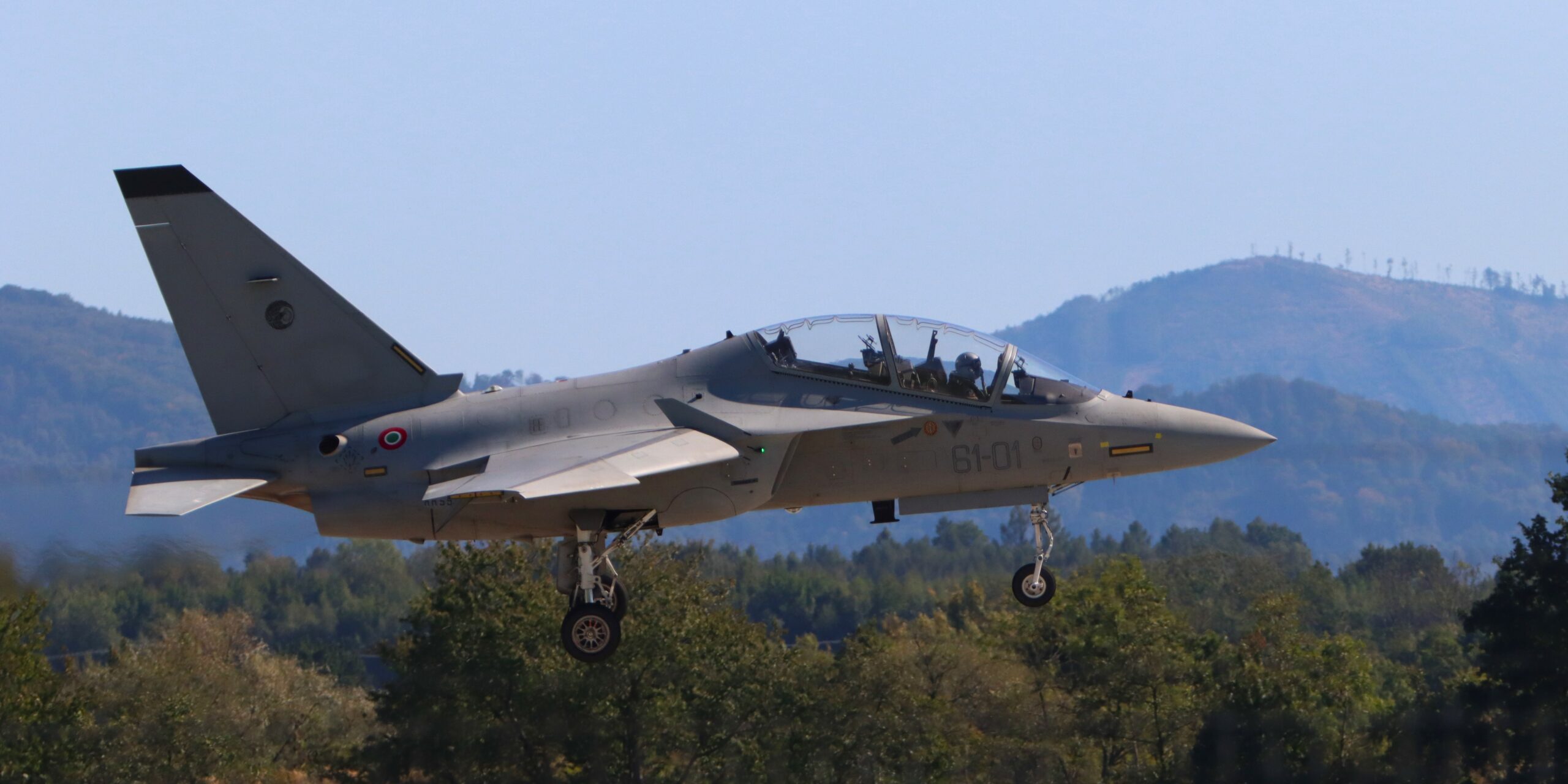Kraków 2025-09-28
Leonardo M-346 Master.
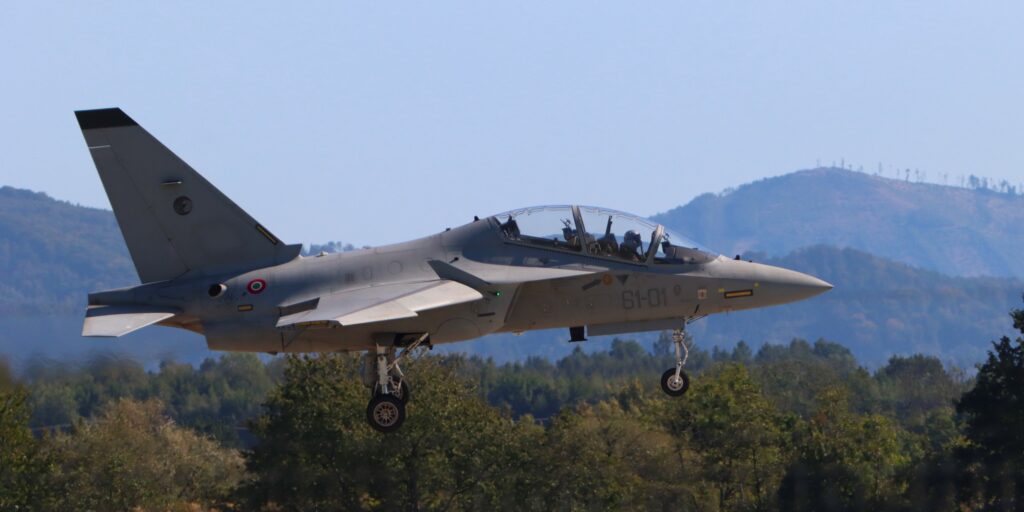
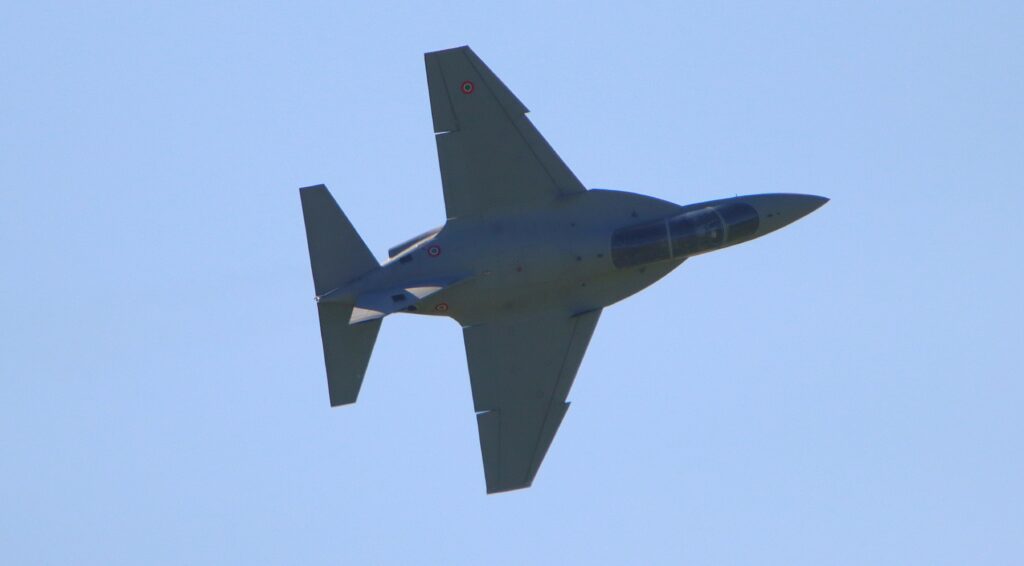
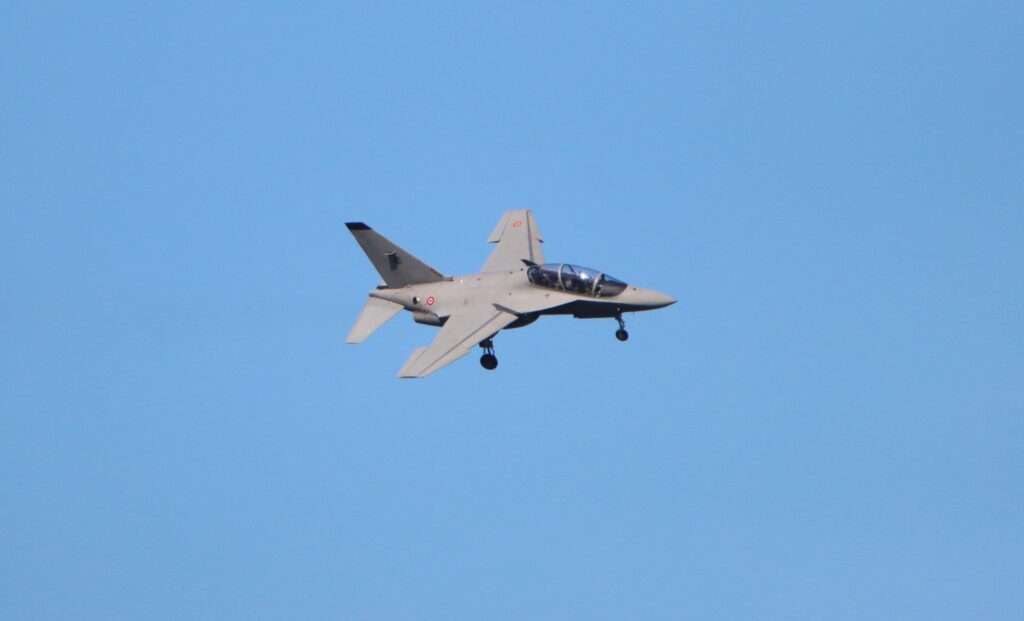
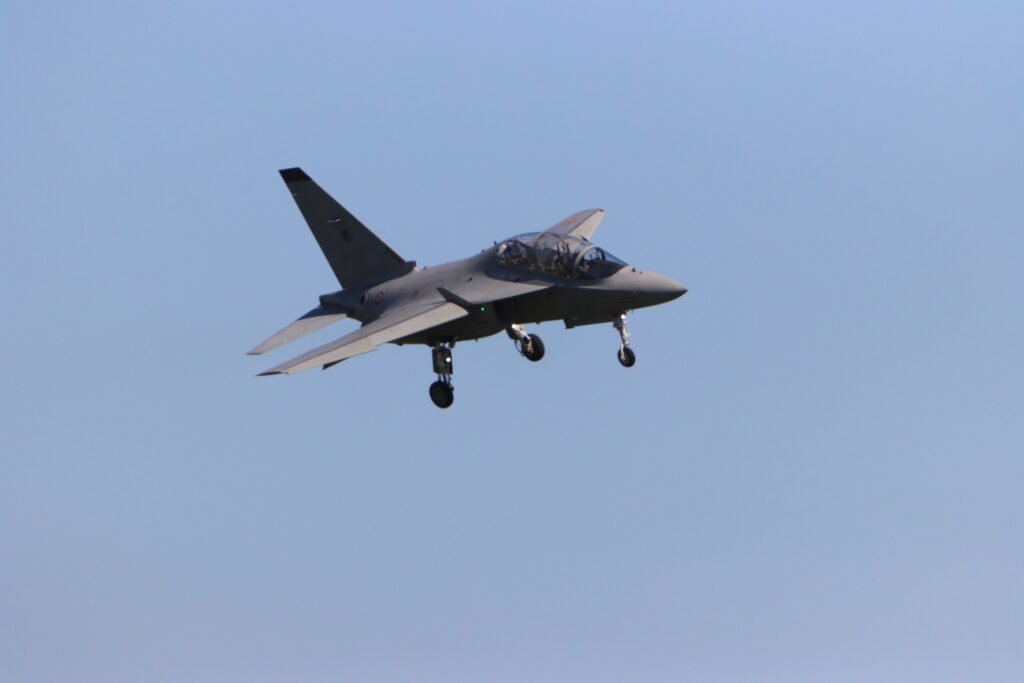
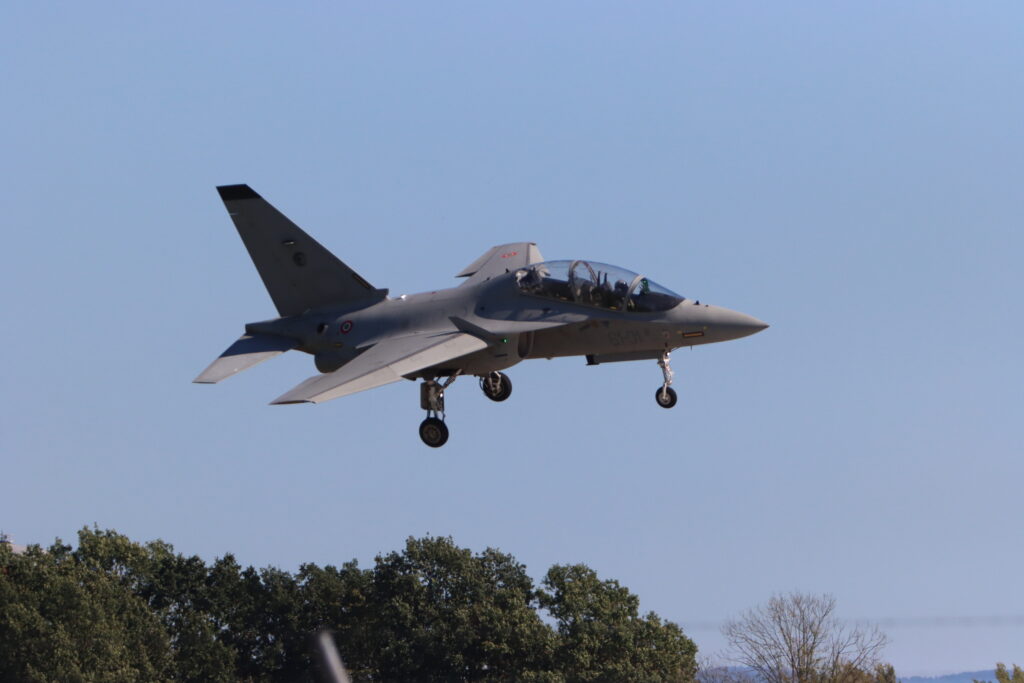
Leonardo M-346.
To date (September 2025), approximately 146 units have been ordered. As of April 2024, 88 units have been delivered. The global M-346 fleet has already exceeded 100,000 flight hours. The aircraft have been ordered by numerous countries: Italy, Poland, Singapore, Israel, Qatar, and Greece. Polish military officials emphasize the aircraft’s excellent reliability, emphasizing that it is a truly international aircraft. Poland has expanded its M-346 Bielik fleet to include 16 examples. The aircraft features modern avionics, a digital control system, and the ability to simulate various malfunctions in flight. The aircraft can be armed, equipped with radar, or reconnaissance systems. Its modular design (open architecture) allows for extensive modernization of combat or training capabilities. The M-346 FA version can also perform combat missions, increasing the aircraft’s utility value.
Poland reported delays in the delivery of the M-346 Bielik aircraft. The manufacturer struggled to deliver all the functions in the simulator required by the contract. The Ministry of National Defense demanded contractual penalties from Leonardo due to the delays. In Poland’s case, one of the allegations was that the M-346 simulator did not simulate certain types of weapons used by Polish F-16s. This limited the value of training for pilots who later transitioned to Lockheed Martin F-16s. We don’t know how the talks ended, but the aircraft are still in service.
In 2013, the M-346 prototype (registration CMX617) experienced a serious technical problem during flight, forcing the pilot to eject. After this accident, the fleet was grounded. A technical investigation was conducted, and the required modifications were approved.
The basic M-346 version has limited combat capabilities, so not all potential buyers ultimately ordered the aircraft. The Italians struggled to present an armed version, as their philosophy was based on delivering aircraft in a combat version tailored to the specific user.
The M-346 is a modern trainer aircraft, also developed as a Light Combat Aircraft (LIFT). Designed as a subsonic aircraft, it can slightly exceed Mach 1 speed. The two-person crew occupies a tandem configuration. The aircraft’s layout is classic, yet aerodynamically advanced, with a strip wing. It is a high-wing, compact design. It is capable of flying at high angles of attack, around 41 degrees. The primary materials used in its construction are aluminum and titanium alloys, as well as glass and carbon fiber-reinforced composites. The aircraft was developed entirely using computer technology. The airframe’s durability is estimated at 10,000 flight hours, with the possibility of extending it to 15,000-16,000 hours. This is intended to allow for a 30-40-year operational life. The HUMS system is designed to monitor and assess the wear and tear of the airframe and onboard systems. Permissible g-forces are +8/-3.
The M-346 is the world’s first aircraft of its type, where combat capabilities depend on the customer. It all begins with the fly-by-wire system, which incorporates control algorithms designed to ensure the M-346’s control is as close as possible to the basic combat aircraft used by the armed forces. In this way, the M-346 mimics, for example, the Lockheed F-16 Block 50 or the Eurofighter Typhoon. Furthermore, the difficulty level can be increased. This flying philosophy allows for the development of good piloting habits and the avoidance of poor ones, which are difficult to correct later. And that’s not all. The control system provides full control of the M-346 at high angles of attack, up to 41 degrees. The control system has another unique feature: in the event of the pilot losing control or losing orientation, pressing a button returns the aircraft to stabilized, level flight.
The cockpit is a glass cockpit and hot air system. The M-346’s glass cockpit represents the latest generation of cockpits and is compatible with night vision goggles. Each cockpit features three color LCD multifunction displays, a head-up display, and an optional helmet-mounted display. A voice command system can be used, integrated with functions such as the navigation system. Communication systems include VHF/UHF transmitters, an IFF transponder, and TCAS (TLPD). The instrument panel in front of the pilots resembles that of the target aircraft, such as the SAAB JAS-39 Gripen, Lockheed Martin F-22 Raptor, or Eurofighter Typhoon.
A key feature of the M-346 is the Embedded Tactical Training System (ETTS). The ETTS is capable of emulating various devices, such as radar guns and weapons control stations. It can interface with various missiles, bombs, and small arms ammunition, both real and fictitious. After a flight, the collected data is used to evaluate the mission. The data comes from the helmet-mounted sight, the HUD, and recorded conversations.
According to the manufacturer, the aircraft has a radar reflective surface of 20 square meters. The company has developed a reduced detectability kit that reduces the effective reflective surface to one square meter. One of these features is the use of a windshield made of glass containing a sputtered layer of gold. This solution was first used by the French in the 1980s on the Dassault Rafale. The effect was so impressive that even the Americans were amazed. The package includes special elements applied to the leading edges of the wings and tail, as well as other solutions. Depending on the customer, the M-346 aircraft can be equipped with systems that increase the aircraft’s survivability in combat. These include warning radars, flare and dipole launchers, or active jamming systems. The choice depends on the potential theater of operations.
However, we must point out that not all of the components listed above are installed on Polish Leonardo M-346 Bielik aircraft.
Aerodynamics of the M-346 aircraft.
The M-346 aircraft was designed in accordance with the aerodynamics of the 1970s, when the stripped wing was developed. The use of a stripped wing solved a problem common to aircraft with variable-geometry airfoils, most importantly increasing the airframe weight by approximately 10%. The stripped wing, along with its appropriate airfoil, allows the aircraft to maintain controllability at high angles of attack, even exceeding 30 degrees. This is something that cannot be achieved with a swept wing. During prototype testing, the M-346 maintained controllability even at an angle of attack of 41 degrees. With its thin wing profile, wing mechanization, and large wing area, the aircraft achieves high maximum speeds and is capable of carrying a heavy weapons load. At the same time, the takeoff and landing run are acceptable. The stripped wing provides a 50% increase in lift compared to a swept wing while also exerting less drag at typical angles of attack.
A swept wing has a swept wing nose. Its role is similar to that of an aerodynamic guide vane, essentially delaying the separation of airflow from the wing. Due to the wing’s thin profile, the front flap has a relatively large chord. This type of flap was first used by the Americans on the Northrop F-5.
The M-346’s wide fuselage also generates lift, which is not insignificant. Due to the wing’s wing and wide fuselage, the vertical tail must be high to perform its function effectively. The horizontal tail, on the other hand, is relatively close to the wings and center of gravity, resulting in a relatively large surface area. The cabin layout is a design used since the 1960s, when tandem seats were arranged with a raised rear seat. This arrangement eliminates the need for a periscope in the secondary cockpit. Visibility from both seats is similar.
The M-346’s maneuverability is exceptional. The aircraft can perform a steady turn at an altitude of 4,500 m at a speed of 700 km/h, with a turn radius of 3,715 m and a g-force of 5.2g. It can also perform an unsteady turn with a radius of just 200 m. The M-346 performs a rapid roll at a speed of 200 degrees/s. It should be noted, however, that in the current war theater, maneuverability is a secondary parameter. Victory is determined by early detection of the enemy and destroying it with available weapons before it realizes it has been targeted. A combat aircraft, or even a combat trainer, is not an aerobatic aircraft intended to impress the enemy. The famous Soviet Cobras, Super Cobras, and Bells, or the maneuvers developed in the 1950s by our renowned test pilot Janusz Żurakowski, have not been used in air combat. When a combat mission lasts 8-12 hours, the human body cannot even withstand 5g. Furthermore, a person cannot withstand a change from -3g to +7g and will surely die.
Why wasn’t a canard system used? For all its advantages, the canard system has the disadvantage that the loss of lift on the front empennage causes the aircraft to dive until lift returns. That’s why the Piaggio P-180 Avanti has additional surfaces at the front and rear. We believe the PZL-230 Skorpion had no chance of successful implementation. The SAAB JA-37 Viggen isn’t a canard system, but rather an additional lifting surface, a specific type of biplane. Similarly, the SAAB JAS-39 Grippen and Eurofighter Typhoon, where the front surfaces are intended to increase the aircraft’s maneuverability. If the canard system were truly effective, half of commercial aircraft would already have it. Moreover, a forward tailplane on a small aircraft like the M-346 would certainly obscure the view from the cockpit.
The only questionable aspect is the use of two engines. For example, the use of two engines in the PZL I-22 Iryda aircraft was due solely to the lack of an engine capable of thrusting 30 kN. In 2000, the Italian aircraft’s plans did not require the use of two engines. I don’t think the Italians couldn’t have obtained, for example, the General Electric CF34 engine, which has thrust ranging from 41 kN to 89 kN. The argument about improved flight safety doesn’t resonate with us either. Commercial arrangements likely played a decisive role.
The wings are stripped with a 31-degree leading edge sweep. They are equipped with automatic slats, Fowler flaps, and ailerons. Three suspension points are located under each wing, with two additional ones located at the wingtips.
Pilots have Martin Baker/SICAMB Mk.16D 0-0 ejection seats.
Aircraft’s tail: The aircraft has a classic vertical tail divided into stabilizer and rudder. The horizontal tail is designed as a slab-type structure. The tail halves can operate independently, meaning only one can be operational. As a result, the horizontal tail can function as an elevator, aileron, or with the physical loss of one half.
Aircraft’s landing gear: The aircraft has a classic tricycle landing gear with a steerable nose wheel. All landing gear legs have single wheels. The main landing gear retracts into recesses in the engine nacelles. The nose landing gear retracts rearward into the fuselage. Both the landing gear, brakes, and control surfaces are powered by a dual hydraulic system.
Aircraft Powerplant
The M-346 is powered by two F124-GA-200 turbofan engines, each producing 27.8 kN (2,835 kgf) of thrust, or 2 x 6,250 lbf. The engines are housed in nacelles in the lower fuselage. The aircraft is also equipped with an auxiliary starting engine (APU), which allows for emergency starting even during flight. The use of an APU in this class of aircraft is a novelty. The air intake design ensures a constant airflow at angles of attack of approximately 40 degrees. The power units are manufactured by International Turbine Engine Corporation (ITEC), a joint venture between Honeywell and the Taiwanese manufacturer Aerospace Industrial Development Corporation (AIDC). In the case of the engines intended for the M-346, the Italian company Fiat Avio is responsible for integrating the power units with the airframe. The Italians are also involved in the production of the F124-GA-200 engine, producing the exhaust nozzles and engine mounts. It is worth noting that a variant of this engine, the F124-GA-100, powered the Czech Aero L-159 aircraft, while a version equipped with an afterburner, designated TFE1042, was used on the Taiwanese AIDC F-CK-1A/B Ching-Kuo (IDF) fighter. Variants of the engine were used to power the T-45, SEPECAT Jaguar, L-159 ALCA, and Alenia Aermacchi M-346 aircraft. The Honeywell F124 engine is a bypass engine with a low bypass ratio of 0.47:1. Its afterburner version is designated F125. The engine’s roots date back to the 1970s, when it was developed in Taiwan.
The engine consists of two turbines: a three-stage axial fan, a four-stage axial high-pressure compressor, a single-stage centrifugal high-pressure compressor, an annular combustion chamber, a single-stage high-pressure turbine, and a single-stage low-pressure turbine.
The M-346 Master aircraft burns approximately 3,000 kg of fuel per flight hour.
The fuel system consists of three integral tanks: two wing tanks with a capacity of 395 liters each, and one fuselage tank with a capacity of 1,715 liters. Additionally, three additional fuel tanks (two under the wings on internal underwing suspension mounts and one under the fuselage) can be carried (630 liters each).
The aircraft can be equipped with a flexible air-to-air refueling probe. Installation takes approximately 30 minutes. This system was tested on the second M-346 prototype. Polish M-346s will not use this solution. This is primarily due to the fact that the F-16 Jastrząb is refueled via a rigid hose.
Aircraft Equipment and Avionics
The aircraft utilizes an advanced digital four-channel fly-by-wire system (developed by BAE Systems, Teleavio, and Marconi Italiana), which allows for software modifications to alter the aircraft’s handling characteristics. This allows for the simulation of other aircraft types, as well as the aircraft’s behavior in specific situations, and the limitation of certain parameters, such as permissible angles of attack.
The M-346’s avionics equipment (using systems manufactured by Honeywell and Galileo Avionics, among others), consisting of mission computers, UHF/VHF transmitters and receivers, an inertial navigation system, and an IFF system, was integrated around two MIL-Std-1553B buses. The navigation system, based on laser gyroscopes, was coupled with TACAN, GPS, and VOR receivers. An instrument landing system (ILS) was also incorporated. Both the student and instructor cockpits were equipped with head-up displays (HUDs) and three liquid crystal multi-function displays. The cockpits were adapted for the use of NVG goggles. Interestingly, the avionics were extensively utilized, allowing for reduced development and operating costs. Both cockpits were equipped with digital video recorders, which, among other things, enable the recording of HUD readings. The controls utilize HOTAS technology. Additionally, a voice command system has been implemented. Elbit Targo helmet-mounted displays are also included.
The aircraft is equipped with an onboard oxygen generator (OBOGS).
Aircraft Armament:
The M-346 can carry a total weapon load of up to 3,000 kg, equivalent to a Su-22 strike aircraft. The choice of weaponry is largely dependent on the user, which was determined during the competition and procurement process. The aircraft has a weapon management system based on the MIL-Std-1760 rail. A pod recording training air combat can be carried on the last node of the right wing. A wider range of underslung weapons is planned for the LIFT and LCA (Light Combat Aircraft) versions.
T-T M-346 Master specifications: Wingspan: 9.72 m (31.89 ft). Length: 11.49 m (37.70 ft). Height 4.76 m (4.98 m) (16.11 ft). Wing area 26.00 m2 (23.52 m2) (253.2 ft2). Empty weight 4,610 kg (10,165 lb). Gross weight 6,700 kg (14,770 lb). Maximum weight 9,500 – 10,250 kg (20,945 lb). Payload weight 3,000 kg. Maximum speed 1,059 km/h. Maximum speed Mach 1.2. Climb rate 102 – 106 m/s. Landing speed 166 – 176. Maximum range 1,981 km (1,070 nautical mile). Service ceiling 13,500 – 13,716 m. Take-off run 290 m. Landing roll 550 m. Range to ferry position (fuel in internal tanks) 1,852 km. Range with two additional tanks and 10% reserve 2,590 km. Range with three additional tanks and 10% reserve 2,778 km. Maximum angular turn speed at an altitude of 1,524 m; 14.5 degrees.
Written by Karol Placha Hetman

